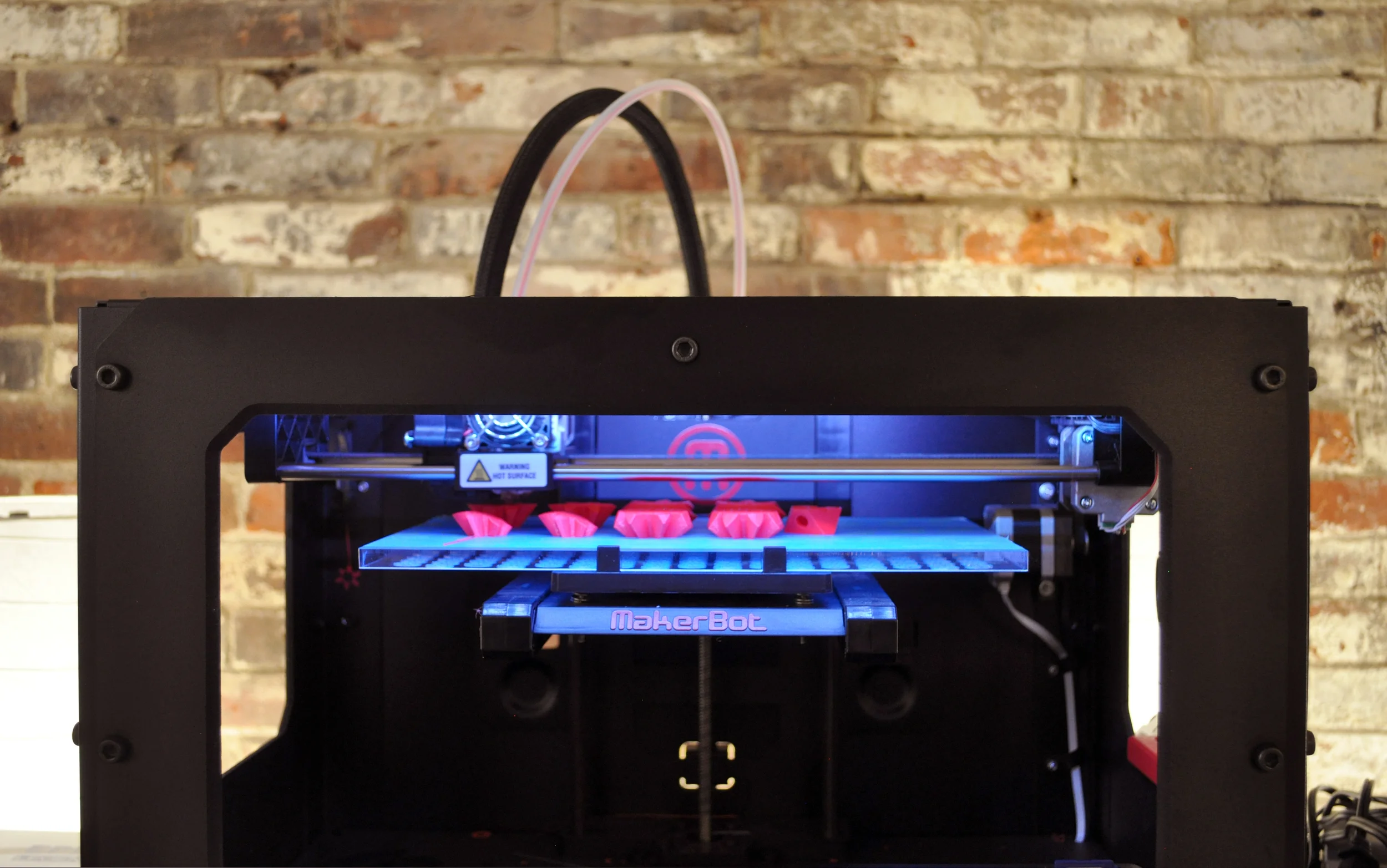Learn how to make a gigantic cardboard geodesic dome with your kids this summer, just like the one we built at our second annual Field Day in New York!
Hack Your Studio: Build a Z-Rack Whiteboard
DtM Book Review: The Back of the Napkin
Cartoons! They carpet the walls of our studio, and they make frequent appearances in DtM presentations and TED talks. In his 2009 book The Back of the Napkin, design thinker and professional doodler...
DtM Open Studio and T-Shirt Printing Factory!
DtM Kicks off CPAP Design Workshops
Today, Design that Matters kicked off a series of design workshops and product implementation coaching with Dr. Ryan Carroll to design an innovative Continuous Positive Airway Pressure (CPAP) device to save babies from respiratory distress and pneumonia. Pneumonia is the leading cause of death in children under five worldwide - more than AIDS, Malaria, or TB. The goal of our collaboration is to expose the CPAP team to design thinking methods and help the team construct strategies for implementing CPAP to have massive impact for the poor in LMICs.
In our first work session together, we were joined by Smitha Gudapakkam from the MGH Center for Global Health. We covered a lot of ground, including forming a point of view about the need, users, and context for the project; creating an hypothesis for how the program will reach massive impact; prioritizing critical assumptions for the project to reach impact; and then brainstorming over 50 ideas for how how the CPAP could be supplied to hospitals. Throughout the workshop, we used quick sketching techniques to make ideas easier to understand and more memorable.
In one exercise, we drew slider bars to better depict tensions inherent in the project. One of the central tensions is between making a device that is extremely easy-to-use right out of the box, versus an assembly of off-the-shelf parts that can be more easily repaired. In the United States, CPAP is one of the few devices that is often assembled by healthcare professionals from off-the-shelf parts, even at the highest level hospitals. Ryan noted that having local technicians and healthcare providers build the devices themselves becomes a critical milestone in their training, building confidence to treat babies.
The workshop was just in time for Ryan to return to Uganda and put these new methods and ideas to work. We look forward to hearing back from Uganda and to taking design thinking even further in our next workshop this Fall!
About the CAMTech CPAP
The CPAP is the center of a novel education program to enable hospitals to diagnose and effectively treat respiratory distress, while building capacity to repair their own CPAP devices locally. The project received the MGH Center for Global Health CAMTech Innovation Award in 2013. Dr. Ryan Carroll is currently co-creating the training program and device with team members from the Mbarara University of Science and Technology and Mbarara Regional Referral Hospital in Uganda.
MIT + RISD Pelican Team Update: Final Review
After a gruelling semester of ups and downs our MIT + RISD team has reached their final presentation, and what a presentation it was! The team’s final design addresses needs DtM had identified from overseas and new insights the student team uncovered during research with health care providers in Boston. Their concept embodies a variety of qualities that make it suited for the developing world context, some include:
- All in one design: eliminates unruly cords that can be easily damaged
- Compact, but not too small: small enough to carry around, but harder to accidentally lose
- Constant Alignment: hinged jaw design keeps sensors aligned, no room for user error
- Torsion Spring: pressure on baby’s foot is controlled by a spring, not the user
- Accommodates Many Foot Sizes: hinged design allows for quick adjustment
- Trigger: no need to fumble with band-aid style sensors, the trigger is simple and intuitive
- Only necessary features: only settings or readings that are needed
We are incredibly proud with all that the team has accomplished this past semester, and can't wait to test the concept in the field with a variety of our internal sacrificial concepts. Thank you Aditya, Esther, Keiichi, Kevin, Leah, Phillip, Shubhang, Victoria and Wei for all of your hard work! We look forward to working with you as we move Pelican forward!
Check out a video of their concept below!
- Will Harris, IDSA
DtM Designer
MIT + RISD Pelican Team Update: Design Review
We would like to take this opportunity to showcase the fantastic work our MIT + RISD student team been doing to ramp up Project Pelican, especially after seeing their great design review this past week. Some of the highlights include:
- Conducting user interviews with a variety of stakeholders including local nurses and moms.
- Creating a “works-like” prototype design with all of the electronics necessary to work as a real pulse oximeter.
- Creating a “looks-like” prototype design that takes into account both the mechanics and usability.
- Building new relationships with local health care providers who have experience in global health and will assist DtM throughout Project Pelican.
- Designing the groovy Pelican logo we have adopted!
We are just weeks away from the student team’s final presentation and we can't wait to see what they produce!
- Will Harris, IDSA
DtM Designer
MIT + RISD Pelican Team Update: Sketch Model Prototyping
This week DtM Designer, Will Harris, traveled to Providence to create some quick “sacrificial prototypes” with RISD Industrial Designers Leah Chung and Kevin Wiesner. Sacrificial prototypes are the earliest of early stage prototypes that are used in product design to illuminate what you don’t know about the problem, and more quickly reach a realistic concept. Some of our internal Pelican “sacrificial prototypes” helped us better understand that we did not fully understand the problem of medical devices accidentally “walking away” from hospitals.
During the work session the team made some big strides, which included:
- Making physical mock ups of the driver board the select along with different battery sizes. After doing that and seeing the actual sizes we were able to start making sketch models based upon those components.
- Creating very simple models and embraced the free pink (blue in this occasion) foam that the RISD model shop had, and focused more on what types of forms or mechanisms that needed to create to fit different sized infant feet.
- Were able to create six new concepts that can form to various newborn feet.
It was an incredibly productive day that lead to some of the first student team physical concepts, allowing them to start doing user interviews at Hospitals around Boston.
- Will Harris, IDSA
DtM Designer
DtM and CAMTech Partner for Healthcare's Grand H@ckfest
The DtM team served as a mentor and partner for Healthcare's Grant H@ckfest. This 48-hour hackathon was hosted by MIT H@cking Medicine, the Kauffman Foundation, and CAMTech. Elizabeth gave a keynote to the more than 350 students, young entrepreneurs, engineers, and medical professionals, using the story of Firefly to illustrate the importance of developing a focused project statement.
During the pitch sessions, DtM presented a new project idea -- a system for connecting medical devices such as Firefly to donors, hospitals, NGOs, and service technicians via sms text message. Our hackathon team, “DataWings for Firefly,” created a working data visualization prototype that won an athenahealth award. The DataWings team was so inspired by the experience that they will continue to work on the project in hopes of creating a proof of concept that we can present during 2014.
Elizabeth's talk at Healthcare's Grand H@ckfest is part of our series sharing lessons learned from the design and launch of Firefly phototherapy. This series is made possible with support from The Lemelson Foundation in celebration of 20 years of improving lives through invention.
Say Hello to Project Pelican!
Say hello to Project Pelican, DtM’s new program to design a pulse oximeter to diagnose newborns with pneumonia. Keeping with the animal themed project names from our most successful projects, Kinkajou and Firefly, the name Pelican was chosen due to the way a pulse oximeter hugs a newborn’s foot reminding us of a Pelican beak.
ABOUT PELICAN
A 2013 Unicef report revealed pneumonia is the leading cause of child deaths worldwide. In 2012, over 1.1 million children, including 330,000 newborns, died of pneumonia. To put this in perspective, 132,000 children died from AIDS, and 462,000 children died from Malaria. Though 1 in 4 childhood pneumonia deaths are newborns, technology targeting newborns remains overlooked. A pulse oximeter is the best way to identify newborns in need of oxygen, and diagnose pneumonia. We are currently designing a spot check pulse oximeter to solve this overlooked problem, and reach 1 million newborns.
DtM Fabricates CAMTech Infant Resuscitator Models for Instant Feedback in Uganda
At a check-in meeting mid-month at the MGH Center for Global Health, Dr. Kris Olson mentioned that the lead engineer for CAMTech’s Augmented Infant Resuscitator (AIR) project was headed to Uganda to test their engineering prototype. CAMTech had worked with an industrial designer to create a set of renderings - photo images depicting the final product appearance. During DtM’s experiences in the field, we found that physical models always generate richer feedback than photos, so we offered to help.
Less than 48 hours after our meeting, Tim presented physical models built on DtM’s 3D printer converting three of their design sketches into reality. Thanks to some speedy design work from Will, who had to come in after hours because of jury duty, the prototypes were precise enough to screw into existing threads on existing Laerdal masks, illustrating how AIR will add functionality to existing resuscitators. The next week, CAMTech team member Kevin Cedrone was in Uganda, testing the concepts with target users. Tim says, Buck Rodgers!














